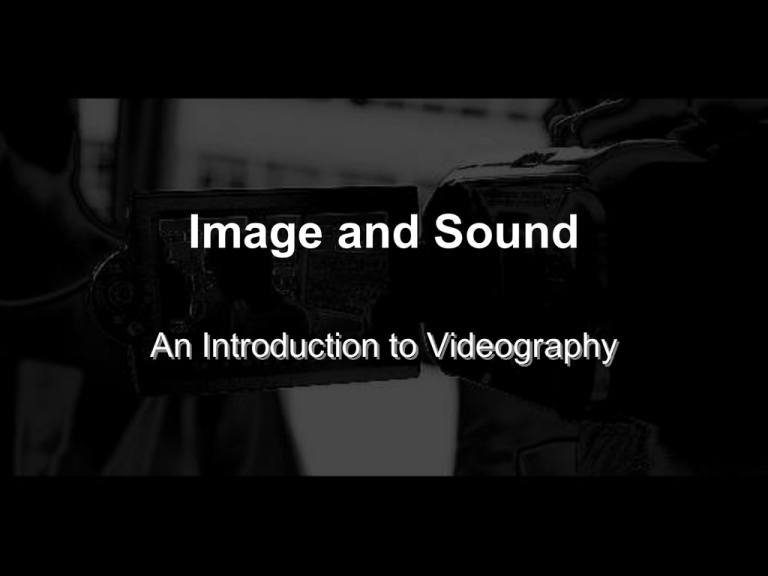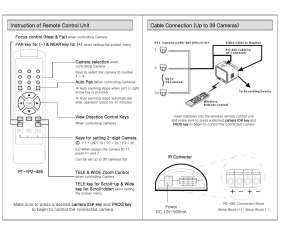Videography training - EN
advertisement

Image and Sound An Introduction to Videography Equipment - Camera - batteries (2) - power supply unit - Tripod and Power Adaptor (Find the right adaptor) - Headphones - K7 mini-dv - Wireless Lapel microphone - Transmitter with microphone - Receiver with headphone Cameras : Panasonic vs Sony - Manuel functions available - White balance, focus, exposure - Microphone input - Headphone input - Manuel functions available - White balance, focus, exposure - Touch screen Camera : Panasonic vs Sony Sound Quality: PANASONIC - You can connect a wireless lapel - You can check the sound quality during the recording Integrated Microphone vs Lapel Microphone Integrated Microphone Lapel Microphone Camera : Panasonic vs Sony You must always check the sound quality prior to filming!!! • Do a test of your recording 1. Once the camera is in place, start recording 2. Ask the interviewee to tell you about their day 3. After a minute, stop recording 4. Rewind the tape and list 5. Make the necessary adjustments Camera : Settings Re-install the original settings PANASONIC In recording mode: MENU – » ADVANCE – » Initial Set – » ON SONY Stylo – » RESET button on the side Camera : Settings OTHER SETTINGS PANASONIC AUTO – Leave as is. MENU – » BASIC – » REC SPEED – » SP – » BASIC – » WIND CUT – » ON – » ADVANCE – » CINEMA – » ON – » SETUP – » AUDIO REC – » 16 bits SONY BEEB – OFF REC MODE - SP AUDIO MODE – 16 bits Camera : Positioning http://www.youtube.com/watch?v=NsDtiHRbFDk Camera : Position The camera has to be at eye level with the interviewee • • The tripod so the camera is at the same height as the interviewee’s eyes • Avoid high angle and low angle shots Camera : Framing RULE OF THIRDS • Assures that there is harmony and balance in the composition of the image. • Makes the image more dynamic and prevents it from static • Place important elements of the image in one third of the frame, where the lines cross. This will emphasis to the viewer, where they should direct their gaze. Camera : Framing RULE OF THIRDS Camera : Framing SCALE Camera : Framing SCALE Camera : Framing The position of the camera and the interviewee Camera : Framing The position of the camera and the interviewee • Avoid placing the interviewee directly in front of a wall • It is better to choose a more interesting background for the interview, one that convery something about who the interviewee is as a person. e.g.: dinner room, living room • Pay attention to the colours and patters of the interviewee’s clothes e.g.: if the interviewee is wearing green, avoid putting them in front of something green Camera : Lighting Basic Rule • Have a light source • Ideally use natural light • Have the light face the interviee or place it at a 45 degree angle from the interviewee Camera : Lighting Basic Rules • Never put the light source behind the interviewee • Try to have a light source that is more diffused then direct Camera : Lighting For the best control, use manuel features (intermiterntly) - Opening/Shutter speed/Sensitivity (ISO) - White balance - Skin tone Timecode • Time indicator associated with the video image • hh:mm:ss:ii (hour : minutes : seconds : images) •e.g. 00:27:31:08 Timecode Timecode • To avoid breaking the timecode - BLACKEN THE CASETTE OR -AVOID REPLAYING THE TAPE Mini DV Cassettes Digital Video Cassettes LABLE • Name of Project • Date of Interview • Interviewee • Interviewer • Videographer • Language NOTES 1. Recharge your two batteries at home, prior to the interview 2. Play with the camera before you shoot the interview 3. Make sure that all the equipment before you shoot the interview 4. Set up the camera near a source of light 5. Set up the camera far away from external noises that might interfere with the filming (e.g. fridge, air conditioner) 6. Ask the interviewee, if possible, if they can turn of the ringer of their home and mobile phones. NOTES 7. Avoid back lighting 8. Set up the tripod (use the water indicator to make sure the camera is leveled) 9. Set up the camera 10. Unpack all the miniDVs before starting to record 11. Place the camera in from of the interviewee 12. Place the camera at eye level with the interviewee 13. Make sure to have a 16:9 ratio rather than a 4:3 ratio. 14. Choose the best settings 15. Test the sound CONTACT PAUL TOM paulshtom@gmail.com









